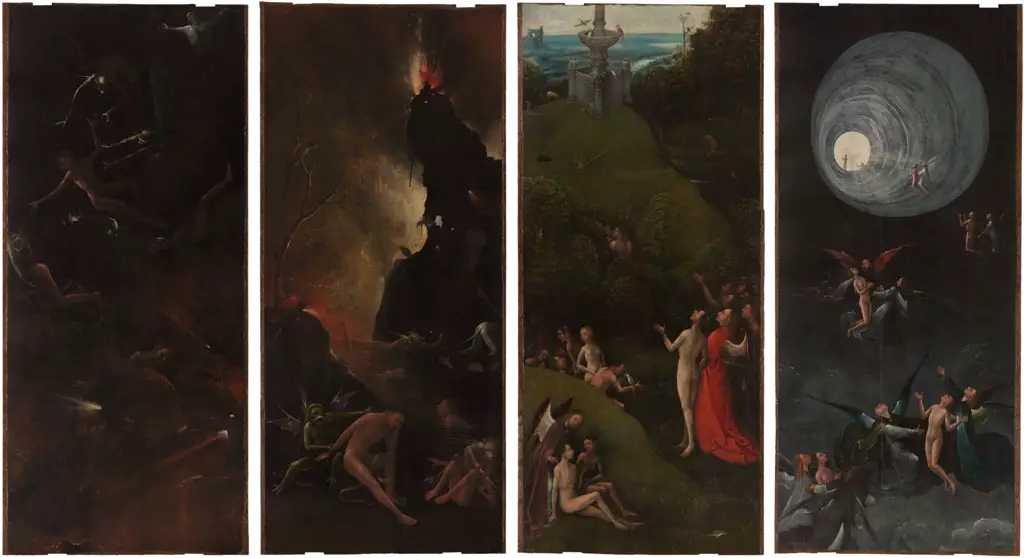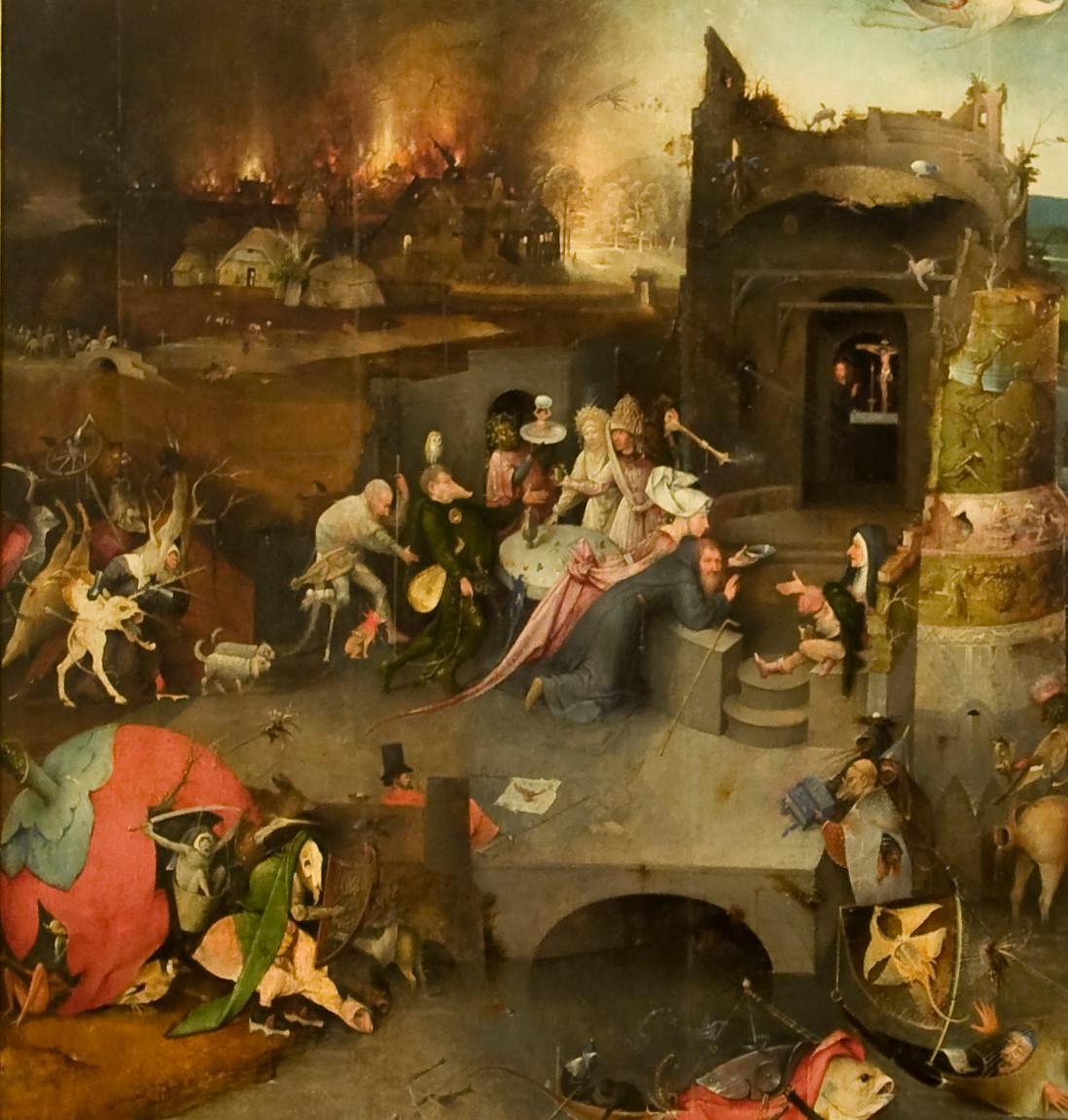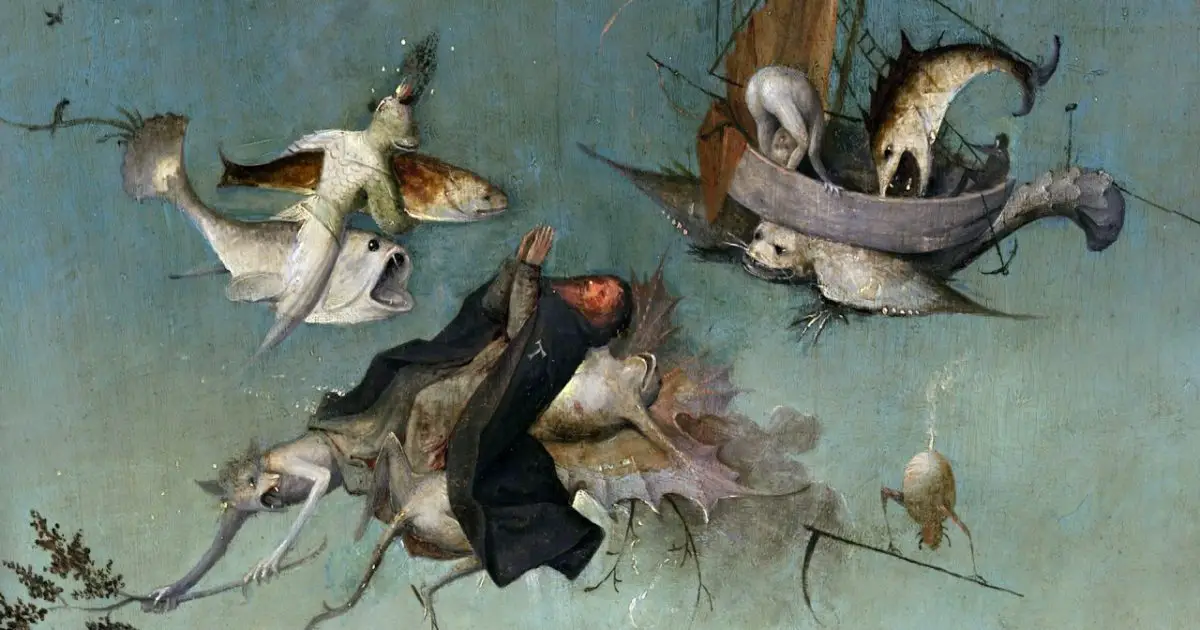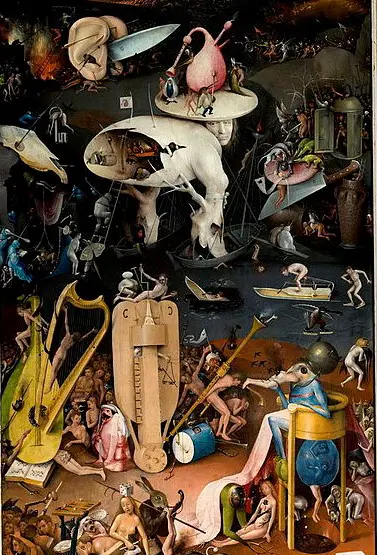A stranger to the idealizing representation of nature, Bosch established himself in the collective imagination as a painter of dream visions, and so he has in fact been defined over the centuries up to the present day: as a painter of the fantastic and of the dream, or even of the nightmare, painter of the demonic and hell par excellence. Yet his works always refer to another reality, in which the traditional categories of Beauty, Eternity and Sense are (still) present, albeit in a renewed form.
di Lorenzo Pennacchi
“Bosch is one of those few painters who have a magical gaze - he was actually more than a painter! He investigated the world of visions, made it transparent and showed it to us as it was originally ". [1]
Whether you have seen it or not at the Museo Nacional del Prado, the Triptych of the Garden of Earthly Delights it is a work that remains firmly in one's imagination. A kaleidoscope of figures with contrasting feelings in which to get lost, through which to overcome the reality principle and rational security. And yet, at the same time, this plethora of suggestions enlivens rational mechanisms, the will to understand, the tension towards knowledge. On this premise the research begins. You come across, almost by chance, one of the many versions (the reduced one) of the wonderful edition of Taschen edited and commented by Stefan Fischer, which presents the complete work of the Dutch painter. The dreamlike-fantastic elements of the Garden they find confirmation in other works by the artist and this acquisition leads to a confrontation with a study done in the past. That's the beauty of culture: stratification and relationality.
In his introduction to Malevich, Joseph Di Giacomo, in the wake of the Aesthetic theory by Theodor W. Adorno, distinguishes three types of art: traditional, avant-garde and modern. The first, located between the fourteenth and nineteenth centuries, "is characterized by an increasingly strong naturalism and mimicry, as if the painting had the function of reflecting reality, so much so that it stood aside as a painting to make reality appear itself " [2]. The reaction to works of this type can be summed up in the formula «How beautiful! It seems real " [3]. Evidently, this classification and the resulting judgment do not marry with Hieronymus Bosch.

At the same time, he cannot be considered a modern for reasons not only of time, but also and above all of content, given that since the twentieth century "this naturalistic and illusionistic line is interrupted and attention is increasingly focused on the elements of the painting and not on what the painting represents, so much so that it can be said that it does not "represent" something other than itself but "presents" itself " [4]. Bosch is therefore an avant-garde. His paintings do not present themselves, but refer to another reality. The traditional categories of Beauty, Eternity and Sense are (still) present, albeit in a renewed form. A radical innovation capable of arousing, among contemporaries and non-contemporaries, an incredulous comment such as «How beautiful !? It doesn't seem real. " Fischer seems to corroborate this perspective [5]:
“In an era, defined by some Late Gothic and others Early Renaissance, in which art tended more and more towards harmony and splendor, illusionism and monumentality, the Dutch painter Hieronymus Bosch (1450-1516) traveled a completely different path. […] A stranger to the idealizing representation of nature, Bosch would then be a painter of dream visions. And so it has in fact been defined over the centuries up to the present day: how painter of the fantastic and the dream, or even the nightmare, as a painter of the demonic and hell par excellence ".
This reduction of his work to the dimension of the fantastic and the dream has been used by many in a negative sense. In fact, many did not understand Bosch. They could not do it, because in this lies the bitter destiny of the innovator. Few have realized that his was not a vile dream escape, but a continuous referring to reality with another, immortal language. We are talking about an erudite artist, perfectly inserted in the social dimension and in the cultural context of his time: "His very art was a Christian humanistic teaching, testified by his extensive knowledge of biblical matters and the lives of saints, but also of medieval symbolism and bestiaries» [6].

It is on this substratum that he actively intervenes, above all through the use of so-called droleries, a term that "appears in the late sixteenth century in France and refers in general to grossly comic and grotesque figurative or scenic representations" [7]. The point is that, even in their German and Dutch counterparts (droplen e grilling), these elements were present in a certain type of representation of the time, that is in the medium-low art, while [8]:
“Bosch made this tradition his own droleries, transferring it from the marginal places of miniature, ornamental architecture and woodcut to panel painting. The extraordinary fact is that many of Bosch's themes find no example in the figurative tradition of the time but can only be documented in literature: in other words, in all likelihood he was the first to transpose them into painting ".
The high training of the artist is therefore voluntarily contaminated by forms up to that moment considered low and completely unrelated to a certain type of artistic content. By doing so, iThe grotesque is elevated, claiming a rightful place in the history of art. And, in the end, he gets it. Let us retrace some stages of this progressive and condensed affirmation, barely hinting at the very rich examination that Fischer makes of it in his volume.

In this detail de The Adoration of the Magi (datable between 1485 and 1500) we can see an anticipation of the droleries. The figures in the background, with dark characters, are led by a semi-naked subject that refers "in a distorted way to the distinctive characteristics of Christ" [9] (the Crown with the intertwining of thorns, the wound on the calf, the charismatic propensity that places him at the head of the crowd). He would therefore evoke the manifestation of the Antichrist.
More than in the realization, the grotesque characters of this scene emerge from its construction. If, as Fischer reveals, the structure of the Triptych is built starting from the narration of the Gospel of Matthew (2,10: 11-XNUMX) [10], why introduce a foreign figure and bearer of a message in contrast with the scene itself? It is the harbinger of the clash, formal and content, which will dominate subsequent productions.

It is with the triptych of the Temptation of St. Anthony (1502) that le droleries they impose themselves as the prevailing elements in Bosch's works. In this detail of the central door, the Saint is crouched on the remains of a tower, while he seeks the viewer's gaze, blessing him. The only figure of comfort is represented by the crucified Christ, firmly in the ruined building, next to which Antonio himself appears, in search of refuge.
The rest is hopelessly corrupt, a haughty one foreshadowing of hell, in which the contaminated subjects interact in disorder: "In contrast to the apparition of Christ on the altar, the devil stages around St. Anthony a parody of the Holy Mass complete with a sermon, music, Eucharist and alms" [11]. The deformity of the figures is accompanied by the destruction of the natural landscape in the background.

In this other detail of the left door of the Tentazione, a scene from the (legendary) life of Antonio is depicted, which Bosch knows through Vitae patrum. Fallen into ecstasy during meditation, the saint is kidnapped and questioned by the demons concerning his sins in his youth. The accusing demons, "devil in the original meaning of the term: slanderers and defamers who bring discord between men " [12], take different forms. A wolf, a knight riding a fish, a crouching homunculus and other grotesque beings they undermine the integrity of the hermit.

The triptych of Garden of Earthly Delights (1503) is Bosch's most famous work. "The function or intention of the work must be understood in its double aspect, namely the didactic and the playful one" [13], although over time very accentuated interpretations have alternated in the first (José de Sigüenza) or second (De Beatis) direction. In the left internal door to dominate, above the union between Adam and Eve sanctioned by God and the idyllic setting populated by fantastic and non-fantastic animals, is the fountain of Eden [14]:
“The fountain is usually depicted as Romanesque or Gothic architecture to indicate the source of the rivers of paradise and show the amenity of the Garden of Eden. Bosch has it essentially represented as a living organism or rather as a vegetable and gave it the same pale red color with which he paints the robe of Christ ".
A totally positive use of supernatural elements and therefore innovative in his artistic career.

The central panel depicts humanity before the global flood. In opposition to the immobility of creation, here everything is in motion, including the organic structures that refer to the fountain of Eden. In the central part highlighted here, the dynamism is exasperated. Around the central basin full of women (a symbol of inclination to sin and widespread folly), an incessant cavalcade of figures proceeds: "The acrobatic riders are the "Fools of Venus" who, spurred on by loving desire, ride in an endless circle. Animals such as the wild boar, the unicorn, the horse, the donkey, the bear, the billy goat, the bull, the dromedary or the camel, the lion and the panther correspond to the vices of luxury, of greediness,accident, of anger and pride, although the order is not always clear " [15].
We add that not all the animals in question must be attributed a negative value. Some, like the unicorn, symbolize virtue rather than vice [16]. Furthermore, the animals present are many more than those reported by Fischer, which further complicates the situation. As well as humanity is presented in its precariousness, the observer's gaze is lost in the superabundance of the proposed elements. Only their marked characterization and the tripartite structural order of the door prevent them from canceling each other out.

The right door represents the hell. Here the previous dynamism has turned into chaos. The figures, although they do not fail the principle of identification, are no longer ordered within the painting. They overlap, they damage each other, they devour each other. Bosch presents the droleries in their most grotesque and irreverent form.
There are two figures that capture the most attention. The first is the giant tree man in the center, a receptacle of sins, not hidden at all, but highlighted by its shameless and provocative posture. Interest in this creature increases even more when a drawing by Bosch titled is discovered The man-tree, datable between 1503 and 1506, in which the protagonist is practically a mirror image, albeit inserted in a completely different context, that is in harmony with the surrounding nature. The second is the "devil defecator on the "throne" bottom right. The blue bird-headed monster sits on a throne that serves as a toilet or high chair and swallows a damned whose anus comes from birds, smoke and fire. The large cauldron on his head illustrates the devil's great appetite " [17].

If, despite hell, observing the Garden of Earthly Delights positive (but not necessarily idyllic) feelings prevail in Universal judgment (1506-1508), the artist's last great triptych, the situation is reversed, as evidenced by the central panel. Based on the Gospel of Matthew (25,31: 33-XNUMX) [18], the painting presents an absolute disproportion between the redeemed and the damned. As Fischer points out, this choice "is unusual in panel painting, where the souls belonging to the two groups are usually represented in almost equal numbers" [19]. The details of the bodies are among the most disturbing: corrupted, ripped apart, burned, hammered by a demonic torturer and impaled on dry trees..
Le droleries, both in the form of gruesome reminders and ecstatic scenarios, continue to alternate in the later works, as in the four Visions of the afterlife. These elements are the main and innovative feature of Hieronymus Bosch, which allows him to establish himself throughout Europe. Among others, Henry III of Nassau and Philip I of Habsburg commissioned him some of his most important works. After his death, Philip II of Spain reveals himself to be a great collector of his and that is why Spain is, even today, the greatest custodian of his works.
Over the centuries, Bosch has been mocked, criticized, defended, elevated and anointed. Yet, centuries after his death, the impression, for experts and the layman, is that his art still has a lot to say. [20]:
“I will continue to think that the secret of [his] magnificent nightmares and visions has not yet been revealed. So far we have opened a few openings in the door of a closed room, but the key to open it has not yet been found ".
Note:
[1] Miller, Henry Big Sur and the Oranges of Hieronymus Bosch, 1957, cit. in Fischer, Stefan The complete work, Taschen, 2016, p. 140
[2] By Giacomo, Giuseppe, Malevich. Painting and philosophy from abstractionism to minimalism, Carocci publisher, Rome, 2014, p. 11
[3] Ibid, p. 11
[4] Ivi
[5] Fischer, Fr. 13
[6] Ibid, p. 14
[7] Ibid, p. 94
[8] Ibid, p. 14
[9] Ibid, p. 72
[10] «When they saw the star, they felt a great joy. Entering the house, they saw the child with Mary his mother, they bowed down and worshiped him. Then they opened their caskets and offered him gold, frankincense and myrrh as gifts. " The Bible, San Paolo Editions, Turin, 2012, p. 2339-2340
[11] Fischer, Fr. 108
[12] Ibid, p. 101
[13] Ibid, p. 143
[14] Ibid, p. 148
[15] Ibid, 161
[16] (edited by) Zambon, Francesco, The Physiologist, 1975, Adelphi, Milan, p. 60
[17] Ibid, p. 170
[18] “When the Son of man comes in his glory, and all the angels with him, he will sit on the throne of his glory. All peoples will be gathered before him. He will separate one from the other, as the shepherd separates the sheep from the goats, and he will place the sheep on his right and the goats on his left. " The Bible, p. 2397. Evidently, right and left are the external doors of the triptych.
[19] Fischer, Fr. 239
[20] Panofsky, Erwin Early Netherlandish Painting, 1953, cit. in Fischer, p. 222
The author thanks Claudia Stanghellini for the valuable advice, the added class and the continued support.

2 comments on “Hieronymus Bosch and the drôleries"